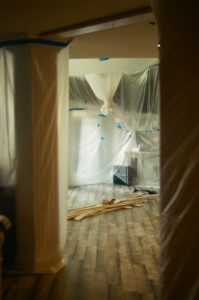It doesn’t matter if you are new to the game, or have been in construction for years. If you don’t use protect materials to match the job, then you’re taking a big risk. Both for the floors of your customers and for your own pocket. However, protecting floors during construction is easy when you know how to. In this post, we introduce you to best practices for contractors who care about protecting floors from damage and contamination during construction.

Best practices for floor protection
The materials you choose for protecting floors are vital. But before you get to that stage, you also need to remember a few best practices that will help ensure you protect the floors of your customers throughout the construction process. Here, we outline our top 3 best practices to consider before choosing the type of protection for your flooring.
- Plot your Route
Before you are able to decide on the sorts of protection you need, you need to know the journey any waste products will need to make. This includes pathways in and out of the house as you don’t want to be bringing dirt into the space every time you try to clear your waste products out. Even if your painting, muddy boots can lead to unexpected dirt being trampled back into the space.
- Seal & Ventilate
Ventilation is always important when it comes to construction work as all sorts of noxious substances and dust can be released into the air. You also want to limit dust spreading from one area of a construction site to another. So it is important to seal up areas you don’t want air spreading things into places they shouldn’t be.
- Clean whilst you go
Just because things are sealed up and protected. It is still always better to clean things up as you go. Otherwise, you risk damaging protective layers. Or this dust will simply circulate when it does come to the time to remove the protective flooring. You may wish to protect against outdoor mess finding its way in on shoes by installing sticky mats in heavy-footfall areas.
How to protect floors
Once you’ve considered the best practices for floor protection during construction work. It’s important to choose the right protection for the right floor type. Here we outline some of the things you should consider when working with different floor types:
- Protecting carpeted floors
When working on carpeted floors, you will need a material that is extra strong and resistant to punctures. A great way to do this is with an adhering film. However, when protecting carpet with film, you need to make sure it is made from sturdy material. Be sure to check how long it can remain in place without deteriorating if you are planning a long construction project. Be sure to choose one that protects against skidding and is highly resistant to tearing.
- Protecting tiled and marbled floors
Tiles and marble might be fairly resistant to things like chairs scratching them. But when it comes to construction work they can be in danger of cracks, chips, and damage from things like falling tools and paint splatter. Fortunately, things like corrugated plastic offer protection against this sort of heavy-duty work, making them a great choice to protect tiled floors during construction.
- Protecting hardwood floors
When it comes to hardwood, you don’t have to worry too much about cracks. However, wood can be fairly absorbent, something you don’t want if you are releasing dust, dirt, or noxious chemicals, into the air. They are also less resistant to paint spills than some surfaces. If wood is damaged, it can also be expensive to replace. Fortunately, a strong paper-based floor covering works well to protect against these sorts of dangers.
Protecting flooring during construction takes time and consideration. However, by following best practices and choosing the right tools to match your materials, you’ll soon be on to a winning strategy.

Recent Comments